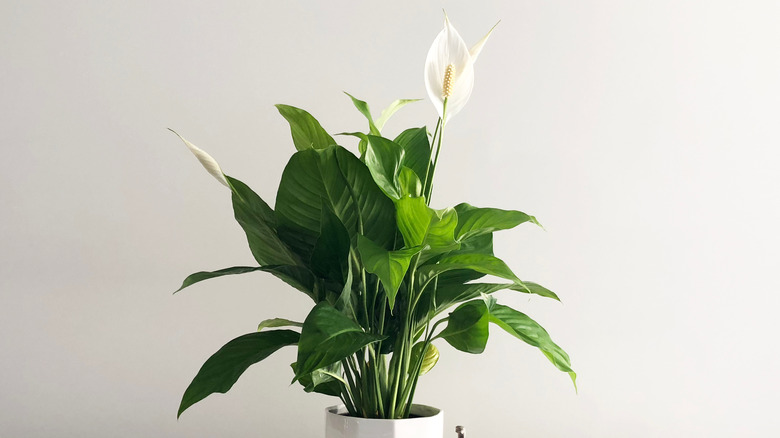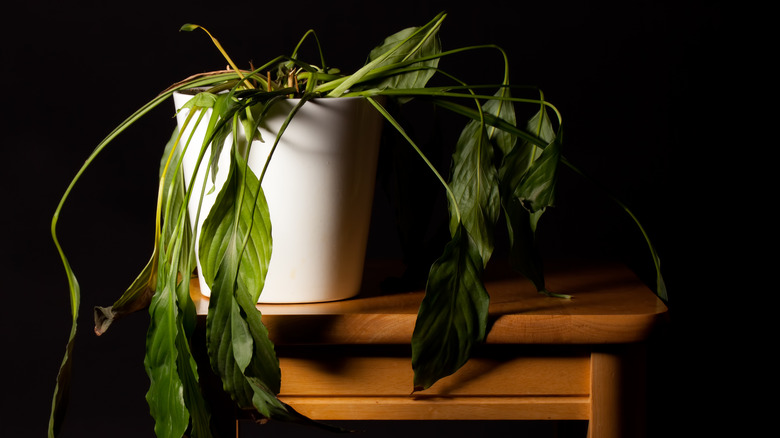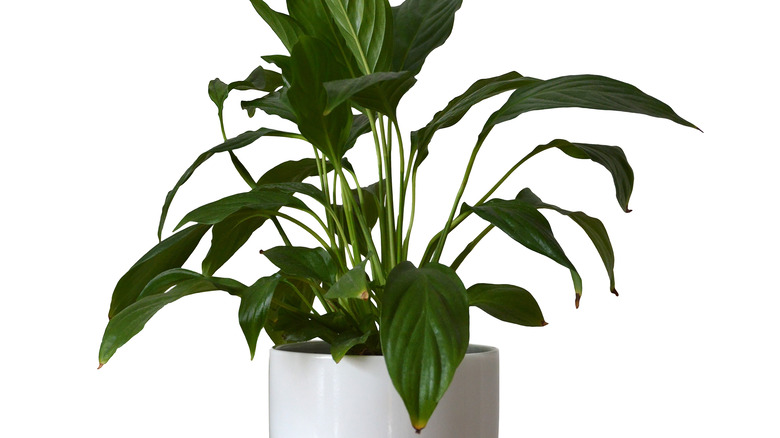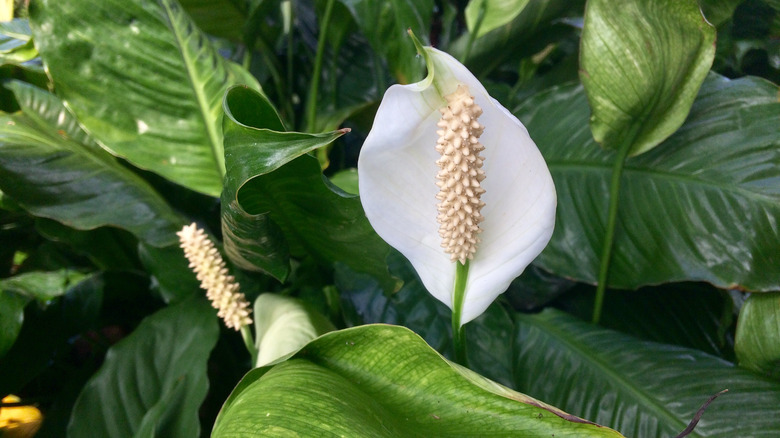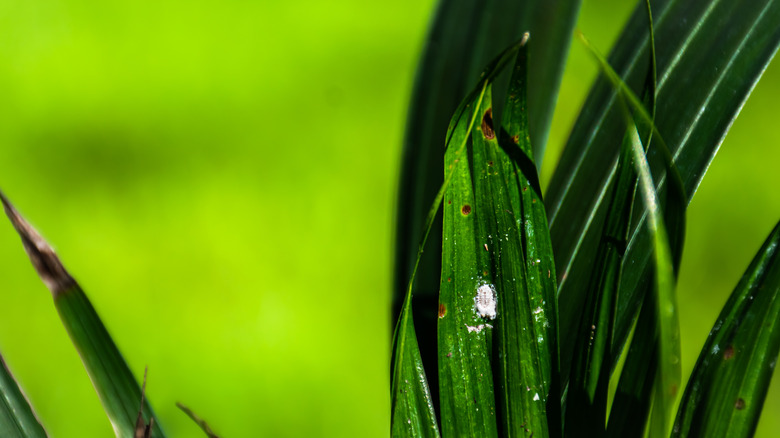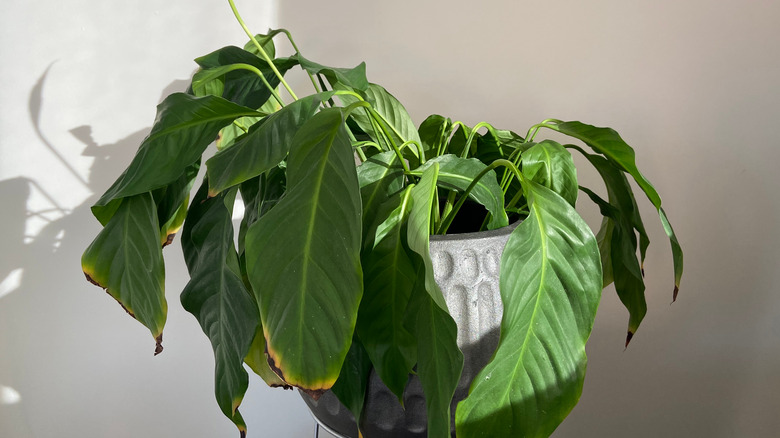Telltale Signs Your Peace Lilies Are In Trouble
Peace lilies (Spathiphyllum) are some of the most popular houseplants around. They come from the Araceae plant family, which is native to tropical parts of the Americas as well as Southeast Asia. The scientific name for peace lilies comes from the Greek words "spath," meaning spoon, and "phyl," which means leaves.
Peace lilies are loved for their deep, emerald-green leaves that are often quite full-looking, and their bright white, teardrop-shaped flowers. Within the white petals of peace lily flowers is a little spike of smaller, yellow or yellow-green flowers, called the spadix (via The Old Farmers Almanac).
While beautiful, tranquil, and relatively easy to care for, one thing is certain when it comes to peace lilies: They are no strangers to drama. You will likely notice right away when your peace lily is in need of some attention, as it will wilt or droop dramatically depending on its needs. Sometimes, a peace lily will seem perfectly fine one day, and on death's door the next. But don't worry, it's just their nature and they can definitely be saved. Here are a few things to look out for when caring for your peace lily.
Wilting or drooping leaves as a result of watering
Being dubbed one of the most dramatic houseplant varieties out there is probably because peace lilies have the most intense wilt. As opposed to other houseplants who show slight and gradual drooping, peace lily leaves will droop almost to the floor as a cry for help.
Typically if a peace lily has wilting or drooping leaves, the concern is watering. According to Gardening Know How, your first step should be checking the soil. Since peace lilies are tropical plants, they prefer regularly moist soil; if your peace lily's soil is bone-dry, it's time to water. Gardening Know How suggests once-a-week watering, but keep an eye on the soil if you live in a particularly arid place. The fun part about owning a peace lily is that even if it does wilt, giving it a good watering will cause the leaves to perk right back up and show a happy, healthy plant.
Aside from underwatering your peace lily, its leaves can be drooping due to overwatering and/or root rot. Miracle Gro notes that you'll want to make sure your peace lily is in a pot or container that has drainage, as they like moist soil but do not like to sit in standing water. Because peace lilies are tropical plants and require constant moisture, it can be easy to overwater them and have water collect at the base of the pot where the roots are, inviting root rot and even pests.
Brown spots on leaves
You may notice some brown, crispy, or streaky spots on your peace lily's leaves, or even its flowers if it has bloomed. While peace lilies are plants that thrive in bright, indirect light environments, exposure to too much sunlight can cause a lot of problems.
Houseplants are, for the most part, pretty sensitive. Unless you are caring for a cactus, watching out for too much sunlight is par for the course for owning virtually any houseplant. This is because too much sunlight can actually burn the leaves and flowers of houseplants, giving them unsightly brown spots. Keep in mind that peace lilies are tropical plants that, in nature, are protected by rainforest canopies and not exposed to a lot of direct sunlight.
If your peace lily has a lot of brown spots or streaks, particularly those that are crispy or crunchy to the touch, it is likely because it is receiving too much sunlight. Gardener Report explains that this can result from moving your peace lily from a shadier area to a spot that receives much brighter and more direct sunlight. Try moving your peace lily away from windows or doors where there is a lot of light to a more indirect (but still bright!) light spot.
Yellow leaves
A telltale sign for almost any houseplant in distress is yellow leaves. Yellow leaves can be occur for a variety of reasons, though you should know the occasional single yellow leaf doesn't mean your peace lily is doomed. But if you are seeing several and/or regular yellow leaves on your peace lily, it's time to take action.
According to the Chicago Tribune, yellow leaves can likely be a sign of a watering issue or a lighting issue. Overwatering is definitely a concern as it can lead to root rot and invite pests, so be sure to let your peace lily dry out a bit before watering again. If your peace lily is in a pot without drainage, consider repotting it to give it fresh soil and to air out the roots.
Yellow leaves can also signal that your peace lily is not receiving enough light, so try moving it to a brighter location (but not too bright, as this can burn the plant). However, the occasional yellow leaf might just be an older leaf lacking nutrients, demonstrating the plant's natural cycle of growing new leaves and letting older ones die off. This instance is not an extreme cause for concern, but can still give an unsightly look to your peace lily. A gentle prune of these yellow leaves will have your plant looking fresh and vibrant, as all the nutrients will be directed to the existing, thriving leaves.
Signs of pests or disease
As can be the case with many houseplants, pests and disease can appear seemingly out of nowhere and can threaten the life of your peace lily. The one good thing about pests being the reason your peace lily is distressed is that they are relatively easy to spot and treat.
According to Gardening Know How, mealybugs are one of the most common issues for virtually any houseplant. You can tell if your peace lily has mealybugs by giving them a thorough look-over for any white, cottony-looking bundles on your peace lily's leaves. You can treat mealybugs with DIY solutions like rubbing alcohol and dish soap or with neem oil, a pesticide commonly used to remove pests.
It's also important to keep an eye out for any other abnormal-looking features on your peace lily, including any bugs, change in soil color, or the appearance of fuzz or mold. Any of these signs can indicate pests or disease and should be treated immediately. While pests and/or disease may not necessarily cause your peace lily to wilt, they will usually change the appearance of your plant enough for you to notice and take action.
Wilting, drooping, or black leaves as a result of environment
If your peace lily has wilting or drooping leaves and you have ruled out any watering issues, the other likely cause is environmental factors. As we know, peace lilies are sensitive; if it's not a matter of watering, you can look to temperature and/or drafts as the reason your peace lily is drooping.
Because peace lilies originate from tropical environments, they prefer warm and humid environments. Aside from making sure your peace lily is watered properly and receiving the right amount of sunlight, you should also ensure your peace lily is not near any drafts like vents, windows, or doors, and that the environmental temperature is not too hot or cold, or changing too dramatically. Better Homes & Gardens says black tips on the ends of your peace lily's leaves are more likely due to an issue with humidity rather than a watering issue, and suggests grouping your peace lily with other houseplants to create a more full, humid environment. If you try this method and don't see any positive changes, try checking your water or fertilizer — there could be excess salt or chemicals preventing the right kind of growth for your peace lily.
